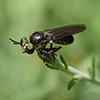Yellow-faced micropanther
(Cerotainia macrocera)
Conservation • Description • Habitat • Ecology • Distribution • Taxonomy
|
|
||||||||||||||
Description |
Yellow-faced micropanther is a small robber fly. It occurs in the United States east of the Great Plains and in southern Ontario Canada. Adults are active from mid-June to mid-August. They are found in open fields and at forest edges. They are often seen landing on the tips of twigs, leaves, and grass blades. They prey mostly on small flying insects including bees, wasps, and beetles. Adults are 3⁄16″to ⅜″ (5 to 9 mm) in length. The body is black and robust. The head is black, short, and unusually wide. There are two large, brown, compound eyes and three small simple eyes (ocelli). The compound eyes extend above the level of the top of the head (vertex). The vertex is flared posteriorly, much wider at the rear than at the front, and it is deeply excavated, appearing hollowed out. The ocelli are arranged in a triangle on a high, narrow, rounded projection (tubercle) in the middle of the head between the compound eyes. The hairs on the vertex and the upper side of the front of the head (frons) are brownish yellow. The face is very short. The antennae have 3 segments. The first segment is unusually long, the second segment is bead-like, and the third segment is as long or longer than the first two combined. The thorax is black and short. It appears humped when viewed from the side. The upper surface is shiny and it is densely covered with short, recumbent, pale yellow to brownish hairs. Though dense, the hairs do not obscure the shiny black surface. The hairs on the sides of the thorax are grayish to sometimes yellow. The abdomen is short, robust, black, and somewhat shiny. Six segments (tergites) are visible on both males and females. The surface is coarsely pitted (punctate). It is covered with scattered, somewhat appressed hairs in the middle, and longer, more erect hairs on the sides. The wings are clear and lightly tinged smoky brown, becoming paler at the base. The first and second branches of the radial sector vein (R1 and R2+3) join before the end of R1 creating a closed cell that does not reach the margin. The legs are stout and spiny. On each leg, the third segment (femur) is black, and the fourth segment (tibia) is reddish brown. The femur has fine, white, erect hairs on the sides and on the underside. On the front legs there are several long bristles on the tibia. On the hind legs, there are 3 or 4 long bristles near the base of the femur and several long bristles on the tibia. |
Size |
Total length: 3⁄16″to ⅜″ (5 to 9 mm) |
Similar Species |
Habitat |
Open fields and forest edges |
Ecology |
Season |
Mid-June to mid-August |
Behavior |
|
Life Cycle |
|
Larva Food |
|
Adult Food |
Mostly small flying insects including bees, wasps, and beetles. |
Distribution |
||
|
Sources |
|
| 8/18/2025 | ||
Occurrence |
||
|
||
Taxonomy |
|
Order |
|
Suborder |
Brachycera |
Infraorder |
Orthorrhapha |
Superfamily |
Asiloidea |
Family |
|
Subfamily |
Laphriinae |
Tribe |
Atomosiini |
Genus |
Cerotainia |
Subordinate Taxa |
|
|
|
Synonyms |
|
Laphria macrocera |
|
Common Names |
|
yellow-faced micropanther |
|
Glossary
Femur
On insects and arachnids, the third, largest, most robust segment of the leg, coming immediately before the tibia. On humans, the thigh bone.
Frons
The upper front part of an insect’s face, roughly corresponding to the forehead.
Ocellus
Simple eye; an eye with a single lens. Plural: ocelli.
Punctate
Dotted with pits (punctures), translucent sunken glands, or colored spots of pigment.
Tergite
The upper (dorsal), hardened plate on a segment of the thorax or abdomen of an arthropod or myriapod.
Tibia
The fourth segment of an insect leg, after the femur and before the tarsus (foot). The fifth segment of a spider leg or palp. Plural: tibiae.
Tubercle
On plants and animals: a small, rounded, raised projection on the surface. On insects and spiders: a low, small, usually rounded, knob-like projection. On slugs: raised areas of skin between grooves covering the body.
Vertex
The upper surface of an insect’s head.
Visitor Photos |
||
Share your photo of this insect. |
||
This button not working for you? |
||
Babette Kis |
||
Cerotainia macrocera (yellow-faced micropanther) Cerotainia macrocera, yellow-faced micropanther, photographed at Barnes Prairie, Racine Co. WI on July 25, 2025, This robberfly, about 8 mm long, was perched at the top of an aster, near a seasonal pond. |
||
 |
 |
|
MinnesotaSeasons.com Photos |
||
|
||
|
||

Slideshows |
|

Visitor Videos |
||
Share your video of this insect. |
||
This button not working for you? |
||
|
Other Videos |
||
|

Visitor Sightings |
||
Report a sighting of this insect. |
||
This button not working for you? |
||
MinnesotaSeasons.com Sightings |
||
|

|
Created: 8/18/2025 Last Updated: © MinnesotaSeasons.com. All rights reserved. |

